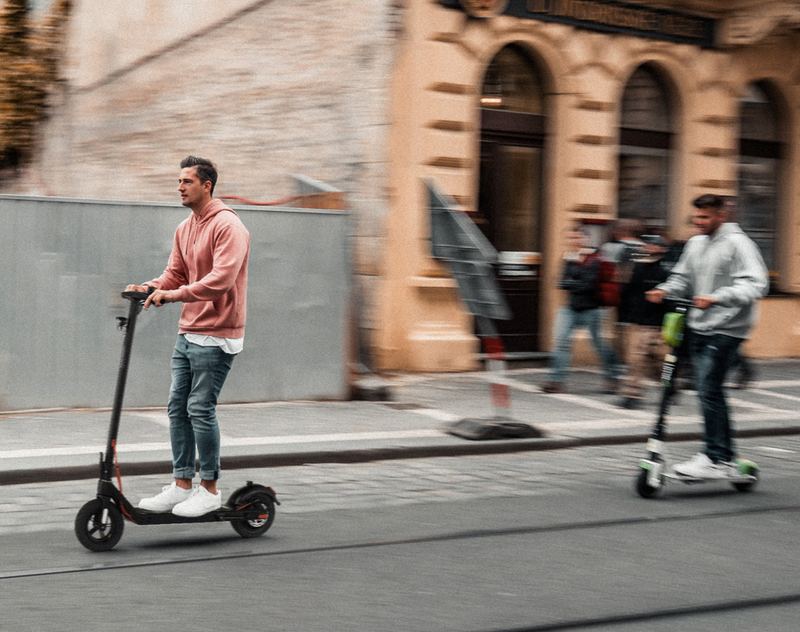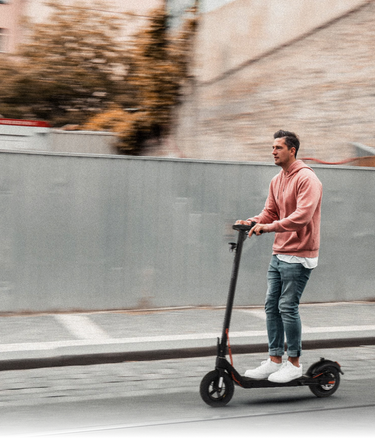Electric scooters are becoming man's favorite automobile. This is probably due to many valid reasons, ranging from eco-friendliness to health and posture improvement. However, do you know what powers an electric scooter? A battery is the energy house of an electric scooter.
An electric scooter battery is where it finds the energy to run its motors, lights, and other accessories. The two major battery types found on electric scooters are lithium-ion-based batteries and lead-acid batteries. You often find the former in most scooters, owing to its longevity and energy density. However, lead-acid batteries are used in most inexpensive children's scooter models.
Aside from the information above, there are other important things about electric scooter batteries you need to know. Read on as we provide a detailed guide about the electric scooter battery.
Part 1. 3 Common Types of Electric Scoooter Batteries
1. Nickel-Metal Hydride Batteries
This is one of the most common batteries found in electronics. Also known as NiMH, these batteries have a high energy density. In other words, they can store charge optimally. On the downside, these batteries charge very slowly, sometimes taking up to 10 to 12 hours. They also witness a voltage drop in extreme temperatures.
2. Sealed Lead-Acid Batteries
You often find sealed lead-acid batteries in cars and other automobiles. While they store energy, these batteries are bulky and heavy, making them less than ideal for use on a scooter. It also takes quite a long time to charge this battery. On the brighter side, they are inexpensive.
3. Lithium-Ion Batteries
This is the best battery for an electric scooter. They also find applications in other smart devices like laptops and phones. These batteries have an excellent energy density and are very light compared to other rechargeable batteries.
Furthermore, lithium-ion batteries store an electrical charge for hours and lose about 5% every month. This is in contrast to nickel-metal hydride batteries that lose about 20% monthly.
There are different subcategories of lithium-ion batteries;
- Lithium manganese oxide (IMR, LMO, and Li-manganese)
- Lithium manganese nickel (INR and NMC)
- Lithium nickel cobalt aluminum oxide (NCA and Li-aluminum)
- Lithium nickel cobalt oxide (NCO)
- Lithium cobalt oxide (ICR, LCO, and Li-cobalt)
- Lithium iron phosphate (IFR, LFP, and Li-phosphate)
All these lithium batteries for electric scooters have their strengths and weaknesses. However, our focus would be on Lithium manganese nickel.
Lithium Manganese (INR, NMC)
This lithium-ion battery is a combination of Nickel, Manganese, and cobalt. They are the go-to batteries for electric scooters and other electric powertrains. It is also the safest lithium-ion battery. The presence of manganese in this combination reduces the battery's resistance while increasing its current output.
One major reason why this battery is ideal for an electric scooter is that they are also safe because their temperature does not rise substantially even with high current output.
Which Battery is Best for An Electric Scooter?
Are you looking for an electric scooter battery replacement? The best battery for an electric scooter is the lithium-ion battery, specifically the lithium manganese nickel (INR, NMC). They are the most stable (temperature-wise) and have an excellent energy density compared to their size. If your electric scooter battery cannot be charged. don't worry. Reading this guide >> Electric Scooter Battery Not Charging? How to Fix? can help you solve most problems.

Part 2. Electric Scooter Battery Specifications
A scooter battery's specifications are not just figures. It influences the efficiency of the battery and, by extension, the scooter. The three main attributes or specifications you should look out for in a battery are
- Voltage
- Charge
- Capacity
Voltage
The voltage of a battery measures how fast it releases power. In other words, it measures how fast the battery releases power to the scooter's motor. Batteries with higher voltage release more power faster to the scooter's motor.
Please note that voltage is just a blanket term, there are two types of voltage;
- Input
- Output
The input voltage has more to do with the battery charger than the battery, which is why we would focus on the output voltage. Most scooter batteries have an output voltage of 24, 36, and 48 volts. You could also see some scooters with an output voltage as high as 96 or 120 volts.
Always remember this rule of thumb, the output voltage should be higher than its input counterpart by a few volts.
Charge
To explain the charge better, let us take a little detour. Matter contains atoms which in turn contain neutrons, electrons, and protons. An atom could have its correct number of electrons, a lesser number, or a greater number.
An atom with a lesser than the normal number of electrons has a positive charge, while that with a greater than the normal number of electrons has a negative charge.
When electricity flows, it is simply the movement of electrons from one point to another. A battery must have a charge to run the scooter the way it should. Electric scooters come with a wide range of battery charges, ranging from 4 Ah (Ampere-hours) to 50 Ah in very powerful scooters.
Capacity
Often expressed in Watt-hours, this specification tells you how much energy a battery can store. Scooter manufacturing brands often omit this information. However, it is easy to calculate.
To know the battery capacity of your electric scooter, multiply its voltage by its charge capacity. In other words;
1 Wh= 1 v x 1 Ah.
Electric scooters have battery capacities ranging from 100Wh to 3000Wh.

Part 3. What Else to Look for in an Electric Scooter Battery
While a battery's charge, voltage, and capacity are important, they are not the only battery attributes you should consider. Below are some other attributes that influence the efficiency of your electric scooter with lithium battery;
- Battery Packs
- Voltage Sag
- Battery Management System
- C-rate
- Battery Brands
Battery packs
A battery pack is a battery unit containing many individual 18650 Lithium-ion cells. This pack often has a large capacity, ranging from hundreds or thousands of watt-hours. A battery pack has a brick-like structure, with its activities regulated by a battery management system in the form of an electric circuit. This battery management system (BMS) controls the inflow and outflow of current into the battery.
Within the battery pack, individual battery cells are connected in a series. When you sum their voltage within this pack, you get a battery's voltage rating.
To increase the current output of these batteries, after connecting the individual battery cells in series, electric scooter manufacturers also connect them in parallel.
Voltage Sag
This is a phenomenon batteries experience. The result is an abnormal behavior of the battery voltage. For instance, the voltage drops beyond normal when you apply load on the battery. However, when you remove the load, the voltage returns to normal.
Several factors could cause this, including electrical resistance, temperature, and lithium-ion chemistry. Another factor that could cause this phenomenon is long rides. It happens here because the electric scooter battery discharges for a long time. And this discharge rate occurs faster than the chemical reaction occurring within the battery. So, when a voltage sag occurs after a long ride, it is a sign that the lithium chemistry is yet to catch up with the battery's discharge rate.
Please note that sag is a temporary phenomenon. Allowing your battery to rest would return it to its accurate voltage level.
Battery Management System
Manufacturers assemble them into battery packs featuring a battery management system to reduce the risks of lithium-ion batteries and increase their efficiency.
This system regulates the battery pack, controlling both the rate of charging and discharging. This system ensures you neither overcharge nor undercharge as both scenarios could shorten the battery life span. Most battery management systems protect the battery by cutting off the power supply from the batteries before you fully deplete them.
Also, some battery management systems regulate the battery pack temperature and can cut off the power supply if overheating occurs.
C-Rate
This describes how quickly a battery charges fully or discharges. For instance, a 1C rating means a battery charges fully in one hour. On the other hand, a 2C rating tells you a battery charges fully in 30 minutes, while a 0.5C rating charges fully in 2 hours.
Battery Brands
Aside from the high-quality brands like LG, Samsung, Panasonic, and Sanyo, a brand's quality control often determines its batteries' quality. Always go for electric scooters made by reputable manufacturers.

Part 4. How Long Do an Electric Scooter Battery Last
How long your electric scooter's battery lasts depends on the following;
- How you ride the scooter
- The weight the scooter carries
- The rate of servicing and scooter maintenance
- The rate of electric scooter use
- If you ride on wet surfaces or when it rains
- The location where you store the electric scooter when not in use
- The battery charging system employed
Ideally, an electric battery scooter will remain optimal for around 300 to 500 charge/ discharge cycles. To put this in perspective, this would give about 3,000 to 10,000 miles. However, improper use and management could considerably reduce the charge cycle and mileage. Managing here does not translate to "petting your battery". It just means doing the minimum to extend battery life because the battery management system already does most of the work.
How To Extend Your Electric Scooter's Battery Life
What is a scooter without a durable battery? We all want our scooter batteries to be in top condition, so we can get the best out of them during long-range rides. Below are some tips to follow to extend your battery life.
- Avoid Draining Your Electric Scooter Completely: Draining your battery is not good for electric scooters. Always aim to keep your battery above 10%. One way to do this is by avoiding difficult terrains like inclines if your scooter is less than ideal for climbing.
- Store Your E-Scooter In a Dry Environment at an Optimal Temperature: There is no one size fits all temperature for scooters. One way to know the ideal temperature to store yours is by going through your Electric scooter's specifications. If you cannot find the ideal temperature, then store it in areas with moderate temperatures. Ensure you avoid placing your e-scooter under the full glare of sunlight.
- Don't Overcharge Your Electric Scooter Battery: Once you fully charge your electric scooter's lithium battery, the ideal thing to do is to unplug it. Also, check the manufacturer's specification for the average or maximum time it takes the scooter to charge fully.
- Do Not Fully Charge Your Scooter If Storing It for Long: If you would be storing the electric scooter for a long time, you shouldn't charge it fully. You can always charge it 50%.
- Always use the correct scooter charger: Even when a charger fits your electric scooter like a glove, it is not advisable to use a different charger on your scooter. Using a charger different from your designated charge could result in battery damage
- Give your scooter time to cool before you plug it into the charger: After a long ride, it is always important you allow your electric scooter to cool before attempting to plug it in. Plugging it in when its temperature is not ideal could reduce the lifespan of the battery.
Part 5. Can You Add an Extra Battery to Your E-Scooter?
Adding an extra battery improves your scooter's performance. Some scooters feature a reinforced frame or extra space just for this purpose. An extra battery improves scooter performance, range, and speed. However, you should take care not to damage the scooter's motor by exceeding its input voltage.
Besides, why buy a scooter that would require an extra battery when you can get the TurboAnt V8 electric scooter with a lithium battery? With its dual battery capacity, this scooter is one of the best long-range scooters on the market. The batteries located in the deck and stem have a charge capacity of 7.5 Ah each. The beauty of this system is that it has a 4-hour fast recharge time since you can charge both batteries simultaneously.
These batteries feed the scooter's 450 W brushless motor, giving it a top speed of 20 mph. They also feed the display system and lights featured on this scooter, alerting you to incoming and outgoing traffic. Besides, this scooter has a load capacity of 275 lb., making it the ideal adult scooter.
With 9.3-inch pneumatic tires, the TurboAnt V8 electric scooter with removable battery gives you a seamless ride, unrivaled in comfort. These big tires make this scooter ideal for use on different roads, including off-roads. It also has a 20% climb capacity, meaning it can climb small inclines easily.
Besides, its dual-spring rear suspension system ensures a very smooth scooter ride, irrespective of how bumpy the travel route is. The TurboAnt V8 electric scooter with removable battery is also lightweight and portable, with its 3-sec quick folding mechanism.
The LCD on this scooter is information-rich, displaying riding mode, both battery levels, headlight status, and current speed. It also displays cruise control status making it one of the best electric scooters with removable battery on the market today.

Part 6. Are Batteries for Electric Scooters Waterproof?
Some electric scooters have an IP rating, making them water-resistant to some degree, but they are not waterproof. However, their IP rating allows them to resist water splashes to varying degrees. Irrespective of an electric scooter's IP rating, it is not advisable to ride through a water puddle or in the rain. Manufacturers warn against this.
However, batteries are very sensitive to water, so manufacturers pay special attention to the battery. Some use casing with a very high IP rating to protect the battery from water damage. Nonetheless, if you do not find an additional rating for your scooter batteries, it is safe to assume it uses the same rating as the scooter.
Finally, if you are not certain about the nature of protection provided to your battery, it is best to assume it is unprotected and avoid water.
The battery is the powerhouse of an electric scooter. Without a battery, the scooter would not function. The Li-ion battery is the most popular battery in electric scooters because of its energy density and stability. When buying a scooter, look for the battery's specifications like charge, voltage, and capacity since they influence the efficiency of the scooter. We believe with everything mentioned above, you now have great insight into electric scooter batteries.























